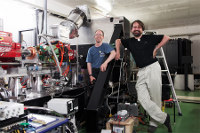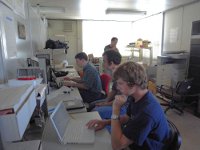 |
 |
|||||||||||||
|
|||||||||||||
|
|||||||||||||
|
At the Accelerator Test Facility (ATF) at KEK, researchers around the world are testing the feasibility of their accelerator techniques. Because the ILC beams are very small, very accurate and precise beam diagnostic measurements are required. Physicists from Notre Dame University, US, and Oxford University, UK, visited ATF2 in July to make tests relevant to beam diagnostic measurement.
One of the very important things for a successful realisation of the International Linear Collider is to measure the precise beam position using Beam Position Monitors (BPM) – only a well-understood beam can be brought to collision and produce the luminosity needed for the expected physics results. First of all the beam position determines the electron and positron beam interaction point. Michael Hildreth, a scientist at the University of Notre Dame, said: “if electron and positron beams are out of alignment, interaction will not occur. Second, it is critical for a technique we wish to use to measure the beam energy at the ILC. Beams at different energies take different curved paths caused by magnetic force, so we know the beam energy by measuring these paths.” BPMs are placed inside the beamline. The BPMs vibrate with small amplitude due to the slight tremor of the beamline support caused by ground vibration. Hildreth measures the vibration of BPMs using a laser interferometer. If the scientists can subtract this effect from the information coming from the BPMs, they can calculate the precise beam position. In this test, the team succeeded in making these measurements. The next challenge? “We hope to monitor the relative position of two BPMs, which are 5 meters apart from each other, to 10 to 30 nanometres.” Two students, Mickey McDonald and Kurt Jung, came to ATF2 from Notre Dame for their internships. “It's a good experience to learn about particle physics,” McDonald said. The monitor for measuring the beam size and the last quadrupole magnet vibrate in random order. Using a technique similar to that for getting the precise beam position, the team must subtract this vibration effect from the information on the beam size to know the precise value. “This vibration is only about ten micrometers in amplitude,” says David Urner, a scientist at the University of Oxford. But the target beam size is in the order of a few nanometers for the ILC. So a vibration in the order of micrometers would affect the beam for the ILC. At AFT2 a system called MONALISA (monitoring alignment and stabilisation with high accuracy) that detects the beamline to very small distances is proceeding to test. “In short, our system works,” said Urner with a proud look. A ll researchers are grateful for the very good support at ATF2. Hildreth said, “people here at KEK and ATF have been very nice and very helpful. So it was a great environment for a first working experience.” Urner said, “everything is done to very high standard. This accelerator has taken a lot of very careful and precise care by good engineers.” Paul Coe said, “when we had some equipment arriving here, on the first of July, the lorry was outside at 9:30 sharp. Within 15 minutes, the boxes were carried inside the lab that I did't get even a chance to take a photo. Too much efficiency is sometimes also a problem!” -- Hiroto Oishi |
|||||||||||||
| © International Linear Collider |

